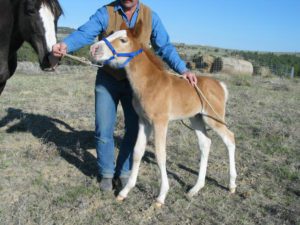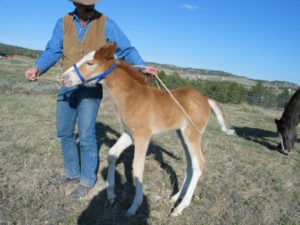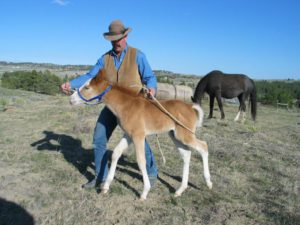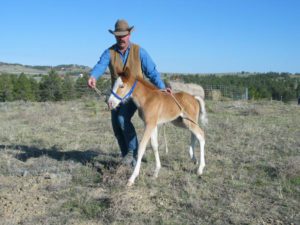Brandon Carpenter 2005
Imprinting your new foal is the first essential step to a well-trained adult horse. Some feel a horse’s training does not start until two to five years of age. Unfortunately, if an owner waits for these years to pass before working with their horse, the opportunity for ingrained mental and emotional training that will last the entire life of the horse has passed.
Imprinting has a long history of use in many cultures. In Montana, our family has used imprinting for generations. We were handling newborn foals extensively to gain their trust well before the term “imprinting” was known to us. Whatever terms are used to describe familiarizing the colt to the human world is immaterial. The importance of molding the colt’s mental processes to human interaction is what is key. Think of your foal’s mental development as the blank slate model of Piaget’s human studies. The sooner your foal knows you, your smell, your voice and touch, the sooner that foal will come to trust you and seek out your company provided the experience is positive.
Just as an infant begins learning from the moment of birth, so does a foal. He or she is developing a sense of what the world is, immediately identifying and assessing hazards. The mare has a tremendous amount of behavioral influence over the foal both good and bad. Therefore if the mare is confident and trusting of people, the foal is more likely to be trusting. If the mare is flighty and wary of you, the colt will fear you simply because mom does. This is imprinting as nature intended. In spite of the maternal influences, the foal will develop his or her own value system for trust based on its experiences. This is where you have the opportunity to make the most of its behavioral development toward humans.
To ensure a horse is confident that humans are safe and trustworthy, a couple basic issues need to be considered. Being a prey animal, flight is the horse’s only defense within a very short time of foaling. We must assure the young foal that flight is unnecessary when we are nearby. Humans need to be viewed as a welcome part of the foal’s social life. We can set ourselves up as a positive member of its social structure, as well as a security figure.
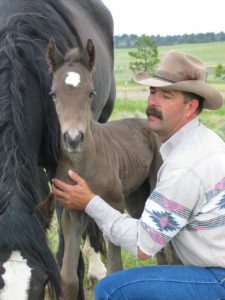
Imprinting is not mystical or magical, but its effects can seem like it with the ease in which you can handle and teach your colt as it matures. In a contest of physical force, your colt will win within a few short months due to its incredible weight gain and muscle development. Therefore we cannot expect to manhandle this animal as it matures, but must work with the intellect and trust of the horse developed from its first moments of life. Luckily, you can physically hold the colt to keep it from moving away from you for the first few weeks. Use this short time to your advantage to solidify in the mind of the colt your ability to control it.
To begin the imprinting process it is vital to have mother and foal nearby where they can be easily handled during the day as many times as possible. Four to six sessions per day are a minimum. Although this seems like a lot of time, each session need only last 10 minutes or so. Remember a colt’s attention span is very short like most youngsters, so do not make too much of a good thing at any one session.
I recommend having a small pasture (a couple acres is ideal) in which to turn your mare loose to monitor her impending foaling. Foaling outside of corrals and in as natural a grassy area as possible is best to avoid infectious complications to the colt. This open area also allows for ample free movement that is important for crucial early hoof and lower leg development of the foal.
Handling the foal after delivery can sometimes be a challenge, but doing so will pay dividends almost immediately. As soon as you have a new arrival, get into the pasture and get your hands on it. However too soon can cause damage to the natural bond between mare and foal. It is extremely important to know when to begin imprinting. Immediately taking charge of the colt as soon as it foals disrupts the natural imprinting that needs to take place between the mare and colt. The colt must recognize the mare as its mother not you! Mares have been successfully foaling for millions of years without our help so leave them alone unless there is an obvious problem that demands your assistance. Too often well meaning owners take great pains to watch the mare foal in order to “help” her with the new baby. “Helping” at this point may confuse the foal as to who will supply its first meal. If you confuse the foal on this matter, you have real problems on your hands and literally may risk the life of the colt. Exercise patience and allow the foal to be dried off and stimulated by the mare. Let it learn to get up on its own, and nurse a couple of times. Allow the mare and colt to bond undisturbed. When you are sure the foal has nursed a few times take this as your cue to begin the human imprinting.
Prepare the mare for your intervention with her colt in the days before foaling. Most horses are suckers for their favorite candies…grain. Walking out a couple of times a day and feeding the mare a few small bites of grain can get her hooked. Your motive is to get her to come to you to get her grain fix whenever she sees you. It is almost unfair to create this dependence, but we will use any reasonable means necessary to reach an important goal. The first impression we want the foal to have is for you to NOT be something to be feared. If mom runs to you, the foal gets the idea you must be a vital and welcome part of everyday life. It’s much more desirable to have her teach the colt to come to you instead of away from you. It should be noted that I do not use treats to train horses. This is simply a method to manipulate the mare’s behavior to get a desired behavior modeled to the foal.
If the colt is already on its feet and well ambulatory when you notice it has arrived, you have the secret grain weapon at your disposal to get close to the mare and colt. Still, caution on the part of the mare is to be expected. In order to approach a new mother, patience must be exercised with diligence. You should move slowly and quietly without sudden movements. Talk to the mare to reassure her and let her know you wish her newborn no harm. Always use caution with the mare, as she can be quite protective of her new colt. Approach the foal at its level. Squat down or get down on your knees so you are not looming high overhead. Remember you do not want to be perceived as a predator or a threat when attempting to make contact with the foal. If the foal smacks its mouth open and closed rapidly and repeatedly it is instinctively giving the sign it is fearful, uneasy or overwhelmed. It’s telling you it is not a threat to you. This is very common baby behavior. I have observed this behavior in a herd by submissive horses as old as two years. This is a signal for you to slow down your movements and refrain from overwhelming it. Reassure and calm the colt until it stops the smacking before continuing.
I like to hold the foal close to my chest while wrapping my arms around its shoulders and rump. Do not squeeze the colt, but don’t allow it to get away from you either. Begin by placing your nose close to the nose of the colt. Allow them to breathe into your nose and gently do the same to them through your nose. Horses are very social animals. This is their first means of communication to each other. If you communicate with the colt on its instinctive level, the trust will begin to develop right away. As you breathe into their nose, gently stroke the neck, shoulders, back and hindquarters. Many foals will resist this and try to pull away, but some seem to enjoy the touching and interaction right away. Never let the colt pull away from you. Permitting such would teach it a lesson you don’t want it to learn! Just as you correct for the smacking behavior, continue to hold the colt loosely until it settles down. All the while, talking in low soothing tones to calm it and familiarize it to your voice.
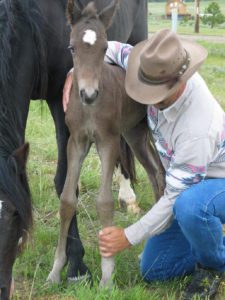
Make sure you can touch this colt everywhere. And I do mean everywhere! Gently place your fingers in its nostrils, mouth, ears, and around the eyes. Slide your hands down the length of its legs and pick up the feet. Gently squeeze the frog in a pulsing motion. Slowly stretch each leg straight forward and back while the colt keeps the leg relaxed. Be sure you do not wrench the hip or shoulder to the side and inadvertently cause any pain. If the colt takes the foot and leg away from you, pick it back up immediately and continue to hold it. Put the foot down only after the colt relaxes. Almost always the colt will be ticklish and jumpy when you touch and massage the belly. Continue until the colt gets used to it. Place your arm under the tail as you continue to hold it close. Run your hands between the legs and inside the thighs. Continue all these lessons until the colt relaxes and accepts what you ask of it every time you ask. This is the very beginning of pressure-release training. Remember to do all the lessons on both sides of the colt. What you teach on one side, you must teach equally on the other side.
Working down the legs to pick up each foot and put pressure on the hoof sole.
While you are building trust from the foal, don’t forget your mare. Remember her primary role is now protector of her new baby. First time mares can be anxious. Be sure to talk to her and handle her so as to minimize her concern. Many times, this will calm a nervous mare and she will be more willing to share her new baby. We have found that mares that have been through imprinting sessions with a couple of their colts become less and less concerned. They will actually graze and show little to no concern from a short distance away. First time mares that were themselves imprinted seem to handle this process with much more acceptance than those who were not imprinted. I believe that is a testament to the effectiveness of imprinting. Consistent, non-threatening behavior on your part solidifies trust in you from both the mare and colt. Why else would a new mother be so accepting of you handling her foal?
Once the colt is comfortable with you touching its face, place a foal-size halter on during this first encounter. This can be a little tricky if they are shy concerning motion around the head. Again, patience is paramount! Place the halter on the foal and allow it to get used to the feel. I recommend placing a small amount of sheepskin on the inside of the halter to prevent rubbing the delicate face. Make haltering a lesson in itself. Put the halter on and take it off multiple times during every lesson so the foal gets used to the confinement feeling of pulling something over its face. Be especially careful to minimize anxiety while teaching this lesson. Constantly monitor its behavior, releasing pressure as the colt accepts the halter. This is such an important lesson that will influence the young horse with nearly every encounter it has with humans throughout life. Make sure the halter is a good fit without being too tight or too loose so a hind foot doesn’t get caught in it when exploring an itch. Make sure you constantly monitor the fit of the halter. The colt grows so fast you may need to loosen the halter a couple of adjustment holes within a two-week period.
Familiarizing the colt to leading provides a major learning curve. You begin teaching the youngster that you control its world. Pressure – release of the halter and rope is a practical lesson that will be revisited throughout life. While standing on the near side of the colt, loop the end of the rope loosely around the rump while holding it in your right hand. Hold the lead snap attached to the halter in your left hand and pull gently forward. Generally the colt will try to back up against the pressure. Continue to maintain the forward pressure of the halter while adding pressure by pulling the loop gently around the rump to encourage forward movement. The instant the colt moves forward release both the pressure on the rump and the halter and give verbal praise. Continue this lesson by first “asking” with the halter lead for a step forward, then increasing pressure forward with the loop on the rump. Usually within a few short sessions the colt is following with halter pressure only!
|
|
|
|
|
|
Control the speed of the colt. Make sure they understand they must stay with you, without taking either the role of “dragger” or “draggee.” Change sides of the colt to round out the lesson. Make sure they will lead from the off side as well as the near side. It is surprising how easy it is to halter break the colt as part of the imprinting process. A day or two after foaling let the colt drag a ten to fifteen foot 3/8-inch diameter rope attached to the halter under supervision. Letting them get the rope wrapped around themselves, stepping on it, and feeling it around their legs teaches them that it isn’t something that is of any concern. They accept the rope as if it is a part of their own anatomy.
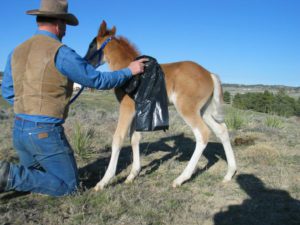
As the colt’s confidence in you builds, you will be able to review the lessons as well as add lessons with less and less resistance from the colt. There is nothing wrong with providing advanced lessons. For instance, teaching them that a piece of noisy material such as a small section of poly tarp or plastic trash bag can actually touch them without sending them to their maker. This initial sacking out of the colt is most easily done sooner than later. It will just be a refresher when formal training begins in a couple of years. Another valuable lesson is to teach the colt to yield to you. They learn to respect your personal space early. The manners and safety implications here are obvious. This helps keep the colt from pushing into you or stepping on your heels or legs as you walk. Good manners also prevent them from crowding or running over the top of you.
Rubbing the sack down the legs, under the belly and over the head and body.
Just as these lessons are great for teaching discipline at a young age, it is important to NOT teach the colt bad lessons or allow them to get away with poor behavior. There is a huge behavioral difference between imprinting with discipline and imprinting by spoiling. More damage can be done to the relationship you create by babying or spoiling a colt. Imprinting poor behavior will remain with them for life also. Spoiled horses can become dangerous without the boundaries manners provide. It is imperative to properly imprint by rewarding only positive behaviors and stopping poor behaviors. If you fail to do this, you will undoubtedly have a pushy, testy 1,200-pound brat that is beyond your control when it matures. Personally I have had better experiences training horses that have had no imprinting at all than those that have been treated as a toy and spoiled.
The best technique for getting depth of imprinting for the new colt is to have several different individuals handle them, continuing the same lessons. We make colt imprinting a family effort. There are absolute rules to imprinting that must be followed with consistency. Each member who takes the responsibility of interacting with the colt knows these rules and abides by them for the benefit of the colt. Generally within about a weeks time, as you approach the pasture, the colt will invariably leave the mare to come to you. When this happens, encourage their pioneering spirit away from mom with additional positive interaction. Often the colt will begin to display some grooming behavior with you. I do not discourage it as long as it is done with respect, and not as an attempt at dominance. The colt is learning to trust and enjoy your company.
After the initial imprinting upon foaling, I prefer to let the mare have the colt for the rest of the summer. Weaning time provides a great opportunity to again work with the same lessons you did at birth. You are now somewhat of a surrogate parent since the colt and mom are permanently separated. This helps to strengthen the colt’s bond with you. Use this time to your advantage to reinforce your role as leader and earn deeper trust and security. A minimal amount of time will be needed to re-establish your role. A few weeks of adjustment from mom and your continued imprinting lessons are really all it takes. Afterward, whenever you have contact with the weanling or later as a yearling and up until formal training begins, take a few minutes to go through the lessons previously taught. You do not have to schedule time to refresh these lessons. Make the continued contact incidental to worming, vaccinations, or any other chore that involves limited contact. It only takes a few minutes and continues to reinforce the lessons as well as maintain the relationship you have established. You are on your way to having a horse that is willing to work for you and not in spite of you. After all, isn’t that what your ultimate goal is with your riding partner?



